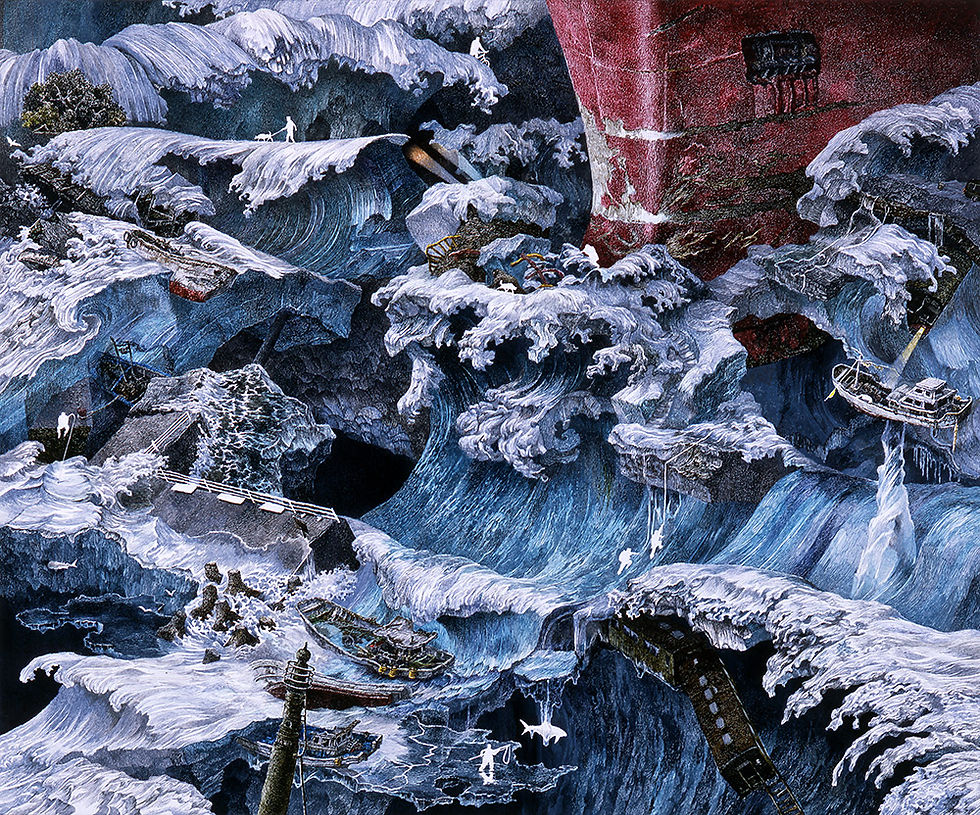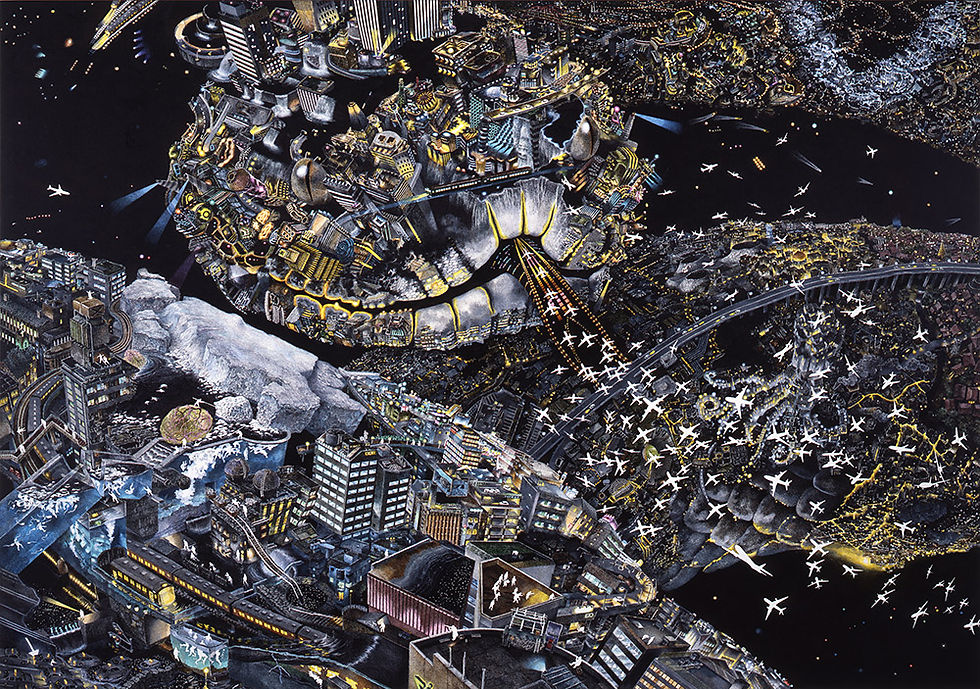GARDEN OF UNEARTHLY DELIGHTS Contemporary Japanese art
- Oct 5, 2014
- 6 min read
Updated: Nov 30, 2024
Garden of Unearthly Delights: Works by Ikeda, Tenmyouya & teamLab
A plurality of approach in mediums, but shared characteristics, curated by Gallery Director, Miwako Tezuka
Japan Society Gallery 333 East 47th Street October 10, 2014 through January 11, 2015
A monster tsunami uproots a city. Modern tough guys lock samurai-style in battle. Candy-colored streams of animals and flowers hyperpixelate. These dramatic visual moments are among those to be encountered in Garden of Unearthly Delights: Works by Ikeda, Tenmyouya & teamLab.
Manabu Ikeda (b. 1973), Hisashi Tenmyouya (b. 1966), and the art and technology collective teamLab (est. 2001) are artistic visionaries who are shaping today’s Japanese art and culture. But each also harkens back to the Japanese tradition of the master craftsmen, takumi, in the level of technical precision and detail they bring to the creation of complex images. This exhibition introduces over twenty intricate allegorical paintings, installations, and digital works by these three artists.
The featured works find an affinity in the hallucinatory vision of The Garden of Earthly Delights, the fantastical triptych by the fifteenth-century Dutch painter Hieronymus Bosch. Just as Bosch did, these three artists collage together imagery and concepts relating to different places and times in the past, present, and future. The results are allegorical depictions of urgent cultural and social issues in a manner informed by their contemporary environment— today’s world of spectacle and information overload.
There is a plurality of approach to mediums in these artists’ works, and yet, seen together, it makes clear some of the notable characteristics of today’s Japanese art shared by all of them—the obsessive attention to detail requiring a vertigo-inducing amount of time to execute, and total immersion in the dense and fast-changing visual sensations of the information society.
MANABU IKEDA

Manabu Ikeda, (b.1973), Foretoken, 2008. Pen, acrylic ink on paper, mounted on board: 72 x 132 in. Collection of Sustainable Investor Co. Ltd. © Manabu Ikeda, courtesy Mizuma Art Gallery. Photo by Kei Mayiajima.

Manabu Ikeda, (b.1973), Ice Stream (Episode from Foretoken), 2009. Pen, acrylic ink on paper, mounted on board: 13 4/5 x 17 5/7 in. Private Collection, New York. © Manabu Ikeda, courtesy Mizuma Art Gallery. Photo by Kei Mayiajima.

Manabu Ikeda, (b.1973), Foretoken (detail), 2009. Pen, acrylic ink on paper, mounted on board: © Manabu Ikeda, courtesy Mizuma Art Gallery. Photo by Kei Mayiajima. .

Manabu ikeda (b.1973), Victim, 2009. Pen, acrylic ink on paper, mounted on board: 27 3/5 x 39 2/5 in. Private Collection, New York. © Manabu Ikeda, courtesy Mizuma Art Gallery. Photo by Kei Mayiajima.

Manabu ikeda (b.1973), Settlement (detail), 2009. Pen, acrylic ink on paper, mounted on board: 7 4/5 x 11 5/7 in. Collection of David Solo. © Manabu Ikeda, courtesy Mizuma Art Gallery. Photo by Kei Mayiajima. .

Manabu Ikeda, (b. 1973), Two Water Surfaces (detail), 2010. Pen, acrylic ink on paper, mounted on board; 8 5/7 x 10 3/5 in. Collection of Mr. Harvey Sawikin and Mrs. Andrea Krantz. © Manabu Ikeda, courtesy Mizuma Art Gallery. Photo by Kei Miyajima.

Manabu Ikeda, (b. 1973), Claw Marks, 2010. Pen, acrylic ink on paper, mounted on board; 8 5/7 x 10 3/5 in. Collection of Katsura Yamaguchi. © Manabu Ikeda, courtesy Mizuma Art Gallery. Photo by Kei Miyajima. .

Using fine point pens, inks, and acrylic pigments, the painter Manabu Ikeda creates detailed compositions comprised of imaginary worlds that are born from his own experiences and contemporary events.
Born in Saga Prefecture in 1973, Ikeda earned his B.A. in design in 1998 and M.A. in 2000, both from Tokyo University of the Arts. In 2011 he stayed in Vancouver, Canada, with a grant from the Agency of Cultural Affairs, Japan. Since June 2013 Ikeda has been working on a large-scale painting at a residency of Chazen Museum of Art in Madison, Wisconsin. This work is expected to be completed in three years.
His recent solo exhibitions include: Manabu Ikeda, The Obuse Museum & The Nakajima Chinami Gallery, Nagano Prefecture, Japan (2009); Meltdown, West Vancouver Museum, Vancouver, Canada (2013), among others. Ikeda has participated in numerous group exhibitions including: Bye Bye Kitty!!! Between Heaven and Hell in Contemporary Japanese Art, Japan Society Gallery, New York, US (2011); Zipangu—The Surge of Japanese Contemporary Art, The Niigata Bandaijima Art Museum, Niigata Prefecture (toured in 2012–13 to Hachinohe, Akita Prefecture, and Takasaki Museum of Art, Gunma Prefecture), Japan; Domani: The Art of Tomorrow 2013, The National Art Center, Tokyo, Japan (2013). His works are in the public collections of Chazen Museum of Art, Madison, Wisconsin, US; Mori Art Museum, Tokyo, Japan; and The Obuse Museum, Nagano Prefecture, Japan.
HISASHI TENMYOUYA

Hisashi Tenmyouya, (b.1966), Rhyme, 2012. Acrylic paint, gold leaf on wood; inkjet print on paper, mounted on wood; each 49 7/8 x 118 1/8 in. Chazen Museum of Art, University of Wisconsin-Madison, Colonel Rex W. & Maxine Schuster Radsch Endowment Fund purchase, 2013.23.1-2a-b. Fiberglass reinforced polyester, calcium carbonate; variable dimensions. Chazen Museum of Art, University of Wisconsin-Madison, John H. Van Vleck Endowment Fund purchase, 2013.23.1-3a-g.

Hisashi Tenmyouya, (b.1966), Baku (Mythological Chimera), 2010. Acrylic paint on wood, gold brocade: 65 3/8 x 59 7/8 in. Chazen Museum of Art, University of Wisconsin-Madison, Chazen General Endowment Fund and John H. Van Vleck Endowment Fund purchase, 2011.27.

Hisashi Tenmyouya, (b.1966), Neo Thousand Armed Kannon, 2002. Acrylic, wood: 89 1/2 x 68 5/16 in. Takahashi Collection, Tokyo. © Hisashi Tenmyouya, courtesy Mizuma Art Gallery.

Born in 1966 in Tokyo, Hisashi Tenmyouya initially worked as an art director at a record music company. He later began his career as a self-taught fine artist. While utilizing a technique of traditional Japanese-style painting (Nihonga), he incorporates genre motifs of contemporary society and street culture. He calls this unique style Neo Nihonga.
Neo Nihonga draws inspirations and motifs of artistic expressions from across the world and imbues in it a strong degree of contemporaneity, social consciousness, and critical thinking. In recent years, Tenmyouya has expanded his artistic approach to include extravagant and dynamic aestheticism of the samurai-termed basara (“outlaw culture”) that, he believes, underlies Japanese culture throughout its long history, reaching beyond the stereotypically more subdued and austere images of Japan according to the notions of wabi, sabi, and Zen.
Some of the major group exhibitions in which Tenmyouya has participated include: Kawanabe Kyōsai and Tenmyouya Hisashi, Kawanabe Kyōsai Memorial Museum, Saitama Prefecture, Japan (2002); The American Effect—Global Perspective on the United States, 1990–2003, Whitney Museum of American Art, New York, US (2003); Berlin-Tokyo/Tokyo-Berlin: The Art of Two Cities, Berlin, Germany (2006); The 17th Biennale of Sydney, Sydney, Australia (2010); Bye Bye Kitty!!! Between Heaven and Hell in Contemporary Japanese Art, Japan Society Gallery, New York, US (2011), among many others. His works are in the public collections of The Museum of Fine Arts, Houston, Texas, US; Chazen Museum of Art, Madison, Wisconsin, US; and Takamatsu City Museum of Art, Takamatsu, Kagawa Prefecture, Japan.
Interview and selected reading
Hisashi Tenmyouya website
TEAMLAB

teamLab (est. 2001), United, Fragmented, Repeated, and Impermanent World, 2013. Interactive digital work, 8 screens; endless, 9:16; sound by Hideaki Takahashi. Courtesy of the artist and Pace Gallery. .

teamLab (est. 2001), United, Fragmented, Repeated, and Impermanent World (detail), 2013. Interactive digital work, 8 screens; endless, 9:16; sound by Hideaki Takahashi. Courtesy of the artist and Pace Gallery. . In 2001, a handful of creatively minded young technologists came together around the leading visionary Toshiyuki Inoko (b. 1977) in Tokyo to form the collective teamLab. A self-proclaimed “ultra technologist group,” it is, figuratively speaking, an experimental incubation laboratory for new ideas and expressions. teamLab now has grown to encompass over 300 members from varying cultural backgrounds and training ranging from art, design, and architecture to computer engineering, mathematics, and more. Its creative forte is in extremely sophisticated digital media work that can be flexibly presented via computers, high definition monitors, and projections according to available space. teamLab utilizes and frequently invents new computer technologies as a method of its creative means.
teamLab has been invited to participate in many international exhibitions and art festivals including: Singapore Biennale 2013: If the World Changed, Singapore (2013); Distilling Senses: A Journey Through Art and Technology in Asian Contemporary Art, Hong Kong Arts Centre, Hong Kong, China (2013); The Japan Media Arts Festival, Aichi Prefecture (organized by The Agency of Cultural Affairs), Japan (2014); and Takamatsu Media Art Festival, Takamatsu City Museum of Art, Kagawa Prefecture, Japan (2014). Japan Society Gallery’s 2014 exhibition Garden of Unearthly Delights is teamLab’s US museum debut.

teamLAB, (est.2001), Life Survives by the Power of Life, 2011. Animation: 6 minutes 23 seconds, 9:16; calligraphy by Sisyu. Courtesy of the artist and Pace Gallery. ……………….………
TOUR
CREDITS

